Although the average person can easily name a dozen or more dog breeds, many consumers don’t realize that the animals we raise for food also come in an array of breeds. To them, a cow is just a cow and a pig is just a pig. But thousands of years of selective breeding have created hundreds of distinct varieties of livestock, each suited to a particular purpose and environment. Thanks to the dominance of industrialized agriculture, however, many of those breeds are disappearing forever, with potentially dire consequences.
What are heritage breeds and why do they matter?

While there’s no strict definition of “heritage” breeds, they’re generally considered to be breeds of livestock that were traditionally raised by farmers before the advent of centralized, industrialized agriculture. They’re the animal equivalent of heirloom fruits and vegetables.
Heritage breeds were developed over the centuries using selective breeding practices that produced animals with many characteristics desirable on a small-scale farm. These include traits like high fertility rates, easy birthing, strong maternal instincts, excellent foraging ability, resistance to diseases, and the ability to withstand temperature extremes. With the rise of large-scale, mass-production-style agriculture, however, the importance of these traits was eclipsed by the desire for animals that grew quickly, put on large amounts of meat easily, and could withstand living in confined and overcrowded conditions.

Because of the needs of the industrialized agricultural system, today most livestock raised commercially in the United States come from only a handful of breeds (in much the same way that we now grow only one or two varieties of many produce items). For example, three breeds make up 75% of all hogs raised in the United States, while 60% of beef cattle are either Angus, Hereford, or Simmental breeds. Suffolks make up 40% of all sheep raised in the United States, and three additional breeds make up another 20%. A whopping 83% of dairy cows are Holsteins.
As a result of focusing on only a few livestock breeds that best fit the industrialized agriculture mold, many heritage breeds are disappearing. In the past two decades, approximately 190 breeds of livestock have gone extinct around the world. This is a problem because fewer livestock breeds means less genetic diversity, which means less food security. What happens if (when) the climate changes or a new disease emerges? If commercial cattle breed A turns out to be highly susceptible to a never-before-seen virus, but there are no heritage cattle breeds B, C, and D to cross-breed with it to improve its resistance, that may mean shortages, sky-high prices, or maybe even the end of beef.
The Livestock Conservancy
 The American Minor Breeds Conservancy was founded in 1977 In response to the growing crisis surrounding the disappearance of heritage breeds. Several decades and a couple name changes later, The Livestock Conservancy has become the preeminent organization working to safeguard the diversity of American farm animals. Its mission is a simple but powerful one: “to protect endangered livestock and poultry breeds from extinction.”
The American Minor Breeds Conservancy was founded in 1977 In response to the growing crisis surrounding the disappearance of heritage breeds. Several decades and a couple name changes later, The Livestock Conservancy has become the preeminent organization working to safeguard the diversity of American farm animals. Its mission is a simple but powerful one: “to protect endangered livestock and poultry breeds from extinction.”
The organization runs a number of programs designed to protect over 150 heritage breeds of cattle, hogs, sheep, goats, chickens, turkeys, and other animals. These include educational resources for farmers, consumer outreach, research, a livestock “census,” and grant-assisted breeding initiatives, among others. The organization also publishes a yearly conservation priority list for livestock and poultry. Similar to the Endangered Species List, these reports highlight which heritage breeds are most at risk of extinction. Breeds are divided into five categories (critical, threatened, watch, recovering, and study) based on global population levels.
How you can help
Luckily, more and more homesteaders and small-scale farmers are turning to heritage breeds. It’s a decision that makes sense from a practical standpoint, since these breeds are better adapted than more modern breeds to thrive on small, local farms. On a more intangible level, turning to heritage breeds allows farmers and consumers to connect to the past and preserve the history and traditions of previous generations. By raising and breeding these animals, farmers are ensuring their continued existence.
So, strange as it sounds, if the meat you buy and eat comes from a threatened heritage breed, you’re actually helping to keep that breed in existence. You won’t find meat from heritage breeds at your big chain grocery store, but if you buy meat from a local farm, whether by the cut or by the animal, be sure to ask which breeds they raise. You can also use The Livestock Conservancy’s online directory to find farms near you raising heritage breeds. If this is a cause that strikes a strong chord with you, you may also want to donate or become a member of The Livestock Conservancy. You don’t need to be a farmer to join, and your membership dues help support their many programs and initiatives.
Appendix A of There’s a Cow in My Freezer includes a list of the breeds to look for when buying beef, pork, lamb, and chicken. Although these were chosen based on the quality of the meat, many of them are heritage breeds.
